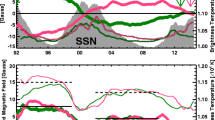Abstract
In recent years remarkable advances have been made in the development of physics based models of various parts of the solar-terrestrial system (see JASTP special issues, October, November 2004; February 2007). In this paper, we focus our discussions in a specific region of the Sun to the Earth’s environment (i.e. 1 AU). It is well-known that geomagnetic storms are caused by solar eruptions. The consequences of these storms include particle acceleration, solar wind impact on the Earth’s magnetosphere and ionosphere, UV-EUV radiation effects on the lower atmosphere, etc. One of the main challenges is to predict the arrival time at 1 AU of the solar disturbance. The prospects look good for an accurate, real-time forecast scheme built on the acquisition of solar, heliosphere and the near-Earth data and large-scale models. However, the accuracy of these models still needs improvement. We will discuss the present status of the models and challenges to improve the simulation models.
Similar content being viewed by others
References
Dryer M, Smart D F. Dynamical models of coronal transients and interplanetary disturbances. Adv Space Res, 1984, 4: 291–301
Smart D F, Shea M A. A simplified model for timing the arrival of solar-flare-initiated shocks. J Geophys Res, 1985, 90: 183–190
Dryer M. Interplanetary shock waves generated by solar flares. Space Sci Rev, 1974, 15: 403–468
Smith Z, Dryer M. MHD study of temporal and spatial evolution of simulated shocks in the ecliptic plane within 1 AU. Solar Phys, 1990, 129: 387–405
Fry C F, Sun W, Deehr C S, et al. Improvements to the HAF solar wind model for space weather predictions. J Geophys Res, 2001, 106: 20986–21001
Fry C D, Dryer M, Smith Z, et al. Forecasting solar wind structures and shock arrival using an ensemble of models. J Geophys Res, 2003, 108(A2): 1070, doi:10.1029/2002JA009474
Feng, X S, Zhao X H. A new prediction method for the arrival time of interplanetary shocks. Solar Phys, 2006, 238: 167–186
Groth C P T, DeZeewu D L, Gombosi T I, et al. Global 3D MHD simulation of a space weather event: CME formation, interplanetary propagation, and interaction with magnetosphere. J Geophys Res, 2000, 105: 25053–25078
Gombosi T L, Tóth G, DeZeewu D L, et al. Semi-relativist magnetohydrodynamic and physics-based convergence acceleration. J Comput Phys, 2000, 177: 176–205
Tóth G, et al. Space weather model framework: A new tool for the space science community. J Geophys Res, 2005, 110, A12226, doi10.1029/2005JA011126
Wu S T, Zheng H N, Wang S, et al. Three-Dimensional numerical simulation of MHD waves observed by the Extreme Ultraviolet Imaging Telescope. J Geophys Res, 2001, 106(A11): 25089–25102
Detman T, Smith Z, Fry C D, et al. A hybrid heliospheric modeling system: Background solar wind. J Geophys Res, 2006, 111: A07102, doi:10.1029/2005JA011450
Manchester W. B. IV, Gombosi T I, Roussev I, et al. Modeling a space weather event from the Sun to the Earth: CME generation and interplanetary propagation. J Geophys Res, 2004, 109: A02107, doi:10.1029/2003JA010150
Manchester W G, IV. Buoyant disruption of magnetic arcades with self-induced shearing. J Geophys Res, 2003, 108,A4, 1162, doi:10.1029/2002JA009252
Wu C C, Feng X S, Wu S T, et al. Effects of the interaction and evolution of interplanetary shocks on “background” solar wind speeds. J Geophys Res, 2006, 111, A12104, doi:10.1029/2006JA011615
Fry C D, Detman T R, Dryer M, et al. Realtime solar wind forecasting: Capabilities and challenges. JASTP, 2007, pp 109–115
Dryer M, Smith Z, Fry C D, et al. Real-time shock arrival predictions during the “Halloween 2003 epoch”. Space Weather, 2004, 2, S09001, doi 10.1029/2004SW000087
Han S M, Wu S T, Dryer M. A three-dimensional, time-dependent numerical modeling of supersonic, super-Alfvénic MHD flow. Comput Fluids, 1988, 6: 81–05
Smith Z, Dryer M. The interplanetary shock propagation model: A model for predicting solar-flare-caused geomagnetic sudden impulses based on the 2 1/2 MHD numerical simulation results for interplanetary global model (2D IGM). NOAA Tech Memo, ERL/SEL-89, July 1995
Arge C N, Pizzo V. Improvement in the condition of solar wind predictions using near-real time solar magnetic field updates. JGR, 2000, 105: 10465–10479
McKenna-Lawlor S M P, Dryer M, Kartalev M D, et al. Near real-time predictions of the arrival at Earth of flare-related shocks during Solar Cycle 23. J Geophys Res, 2006, 111: A11103, doi10.1029/2005JA00162
Plunkett S P, Wu S T. Coronal mass ejections (CMEs) and their geoeffectiveness. IEEE Trans Plasma Sci, 2000, 28(6): 1807–1817
Wu S T, Guo W P, Michels D J, et al. MHD description of the dynamical relationship between a flux-rope, streamer, coronal mass ejection, and magnetic loud: An analysis of the January 1997 Sun-Earth connection event. J Geophys Res, 1999, 104(A7): 14789–14801
Nakagawa Y, Hu Y Q, Wu S T. The method of projected characteristics for the evolution of magnetic arches. Astron Astrophys, 1987, 179: 354–370
Wu S T, Wang J F. Numerical test of modified full implicit continuous Eulerian (FICE) scheme with projected normal characteristic boundary condition for MHD flows. Comput Meth in Appl Mech and Eng, 1987, 64(1–3): 267–282
Wu S T, Wang A H, Liu Y, et al. Data-driven MHD model for active region evolution. Ap J, 2006, 652: 800–811
Feng X S, Zhao Y F, Wu S T. A novel numerical implementation for solar wind modeling by the modified conservation element/solution element method. Ap J, 2007, 655: 1110–1126
Wu S T, Wang A H, Falconer D A. A three-dimensional MHD model of active region evolution. In: Dere K, Wang J X, Yan Y H, eds. Proc Coronal and Stellar Mass Ejections, IAU Symp, 226, 2004, doi:10.1017/S174392130500075X
Falconer D A, Moore R L, Gary G A. Correlation of the coronal mass ejection productivity of solar active regions with measures of their global nonpotentiality form vector magnetograms: Baseline results. Ap J, 2002, 569: 1016–1025
Lu G D, Baker N, McPherron R L, et al. Global energy deposite during the January 1997 magnetic cloud event. J Geophys Res, 1998, 103(A06): 11685
Author information
Authors and Affiliations
Corresponding author
Additional information
STW and AHW are supported by AFOSR (Grant No. FA9550-07-1-0468), AURA Sub-Award C10569A of NSO’s Cooperative Agreement AST 0132798, and NSF (Grant No. ATM-0754378); CCW is supported by NASA grant NNX07AH85G, FENG is supported by National Natural Science Foundation of China (Grant Nos. 40536029, 40621003, 40374056 and 40574058)
Rights and permissions
About this article
Cite this article
Wu, S.T., Wang, AH., Fry, C.D. et al. Challenges of modeling solar disturbances’ arrival times at the Earth. Sci. China Ser. E-Technol. Sci. 51, 1580–1588 (2008). https://doi.org/10.1007/s11431-008-0266-7
Received:
Accepted:
Published:
Issue Date:
DOI: https://doi.org/10.1007/s11431-008-0266-7




